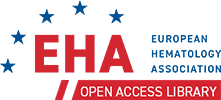Targeting mutated FLT3 in AML
EHA Library. Levis M. 06/14/17; 185050
Topic: 2B Acute myeloid leukemia (AML) and leukemias of ambiguous lineage
Dr. Mark J Levis
Contributions
Contributions
Learning Objectives
Gert Ossenkoppele - Chair Introduction
Acute Myeloid Leukemia (AML) is a clonal disorder arising from hematopoietic progenitors developing in the myeloid pathway characterized by deregulated differentiation and maturation programs. Deciphering of the molecular heterogeneity by rapidly evolving genomic technology has resulted in a multitude of new mutations and gene expression signatures resulting in unique genomic make up of every individual AML. Prognostication is now also based on these new aberrancies.Treatment of AML relies for over 40 years on a combination of cytarabine and an anthracycline aiming to achieve a complete remission(CR) while post remission therapy (either chemotherapy or stem cell transplantation in its various forms) aims to maintain it by eradication of residual disease. Prognosis especially in the elderly population remains very poor, in the younger age segment a gradually improvement have been achieved in the previous decennia resulting in an OS between 40-50%. Nevertheless, new treatment strategies are urgently warranted to improve outcome and to decrease toxicity. A large number of new drugs targeting leukemic drivers or a multitude of deregulated pathways are awaiting clinical application. In this educational session on AML we focus on a selection out of these these topics.
Learning Objectives of the manuscript
After viewing this presentation the participant will be able to:
- Get knowledge of the growing importance of molecular genomics to inform patient care with regard to improved disease classification and risk prediction, MRD monitoring and guiding targeted therapeutic approaches.
- To learn that many new therapies emerge that target cell surface markers, mutated genes, deregulated pathways or immune response that will improve the outcome of the standard of care for AML (3+7).
- To understand that FLT3 inhibition is likely to be incorporated into the management of FLT3-mutated AML.
Learning Objectives of the presentation
After viewing this presentation the participant will be able to:
- Identify the subsets of AML patients that might benefit from FLT3 inhibition
- Describe the different points in AML therapy where FLT3 inhibitors are likely to be incorporated.
- Discuss the different potential roles for selective versus non-selective FLT3 inhibitors.
Acute Myeloid Leukemia (AML) is a clonal disorder arising from hematopoietic progenitors developing in the myeloid pathway characterized by deregulated differentiation and maturation programs. Deciphering of the molecular heterogeneity by rapidly evolving genomic technology has resulted in a multitude of new mutations and gene expression signatures resulting in unique genomic make up of every individual AML. Prognostication is now also based on these new aberrancies.Treatment of AML relies for over 40 years on a combination of cytarabine and an anthracycline aiming to achieve a complete remission(CR) while post remission therapy (either chemotherapy or stem cell transplantation in its various forms) aims to maintain it by eradication of residual disease. Prognosis especially in the elderly population remains very poor, in the younger age segment a gradually improvement have been achieved in the previous decennia resulting in an OS between 40-50%. Nevertheless, new treatment strategies are urgently warranted to improve outcome and to decrease toxicity. A large number of new drugs targeting leukemic drivers or a multitude of deregulated pathways are awaiting clinical application. In this educational session on AML we focus on a selection out of these these topics.
Learning Objectives of the manuscript
After viewing this presentation the participant will be able to:
- Get knowledge of the growing importance of molecular genomics to inform patient care with regard to improved disease classification and risk prediction, MRD monitoring and guiding targeted therapeutic approaches.
- To learn that many new therapies emerge that target cell surface markers, mutated genes, deregulated pathways or immune response that will improve the outcome of the standard of care for AML (3+7).
- To understand that FLT3 inhibition is likely to be incorporated into the management of FLT3-mutated AML.
Learning Objectives of the presentation
After viewing this presentation the participant will be able to:
- Identify the subsets of AML patients that might benefit from FLT3 inhibition
- Describe the different points in AML therapy where FLT3 inhibitors are likely to be incorporated.
- Discuss the different potential roles for selective versus non-selective FLT3 inhibitors.
{{ help_message }}
{{filter}}


